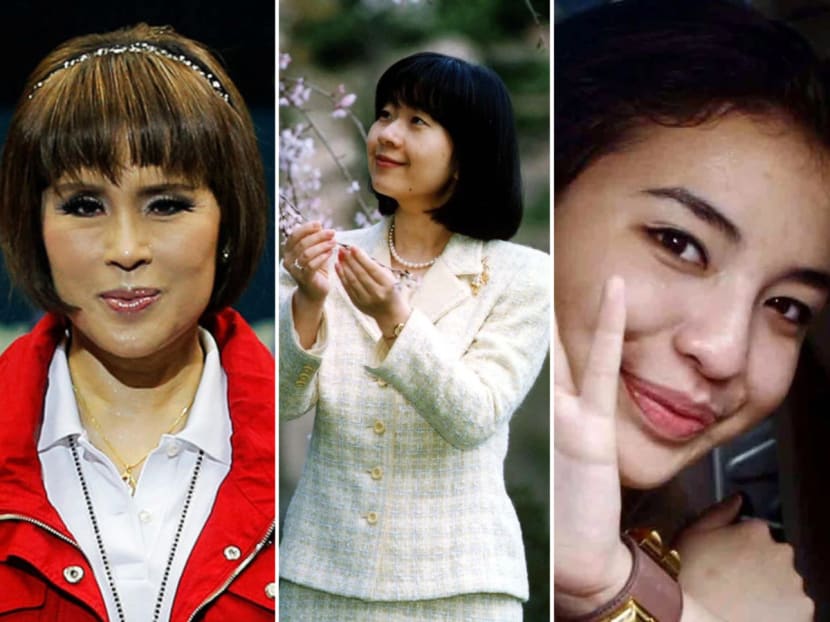Forget Megxit: here are the Asian royals who turned their backs on their titles
HONG KONG — Briton royals Prince Harry and his wife Meghan Markle, the Duke and Duchess of Sussex, created a whirlwind of international headlines when they last week announced on Instagram they would “step back” from royal duties.

From left: Thailand's Princess Ubolratana Rajakanya, Japan's Princess Nori and Indonesian model Manohara Odelia Pinot who married a Malaysian prince.
HONG KONG — Briton royals Prince Harry and his wife Meghan Markle, the Duke and Duchess of Sussex, created a whirlwind of international headlines when they last week announced on Instagram they would “step back” from royal duties.
When announcing their “exciting next step” they indicated they would seek to become financially independent while dividing their time between the UK and North America.
The departure of Harry and Meghan — which immediately became known on social media as “Megxit” — may have been driven by their desire for greater privacy. But they’re definitely not the first members of a royal family to tire of the glare of publicity. Here are several Asian royals who made similar decisions, for a variety of reasons.
PRINCESS AYAKO (JAPAN)
The youngest daughter of Akihito’s cousin followed in her aunt’s footsteps. She left the imperial household in 2018 after marrying a commoner, shipping firm employee Kei Moriya. After signing her marriage papers, Princess Ayako, 29, became Ayako Moriya.
Her departure left just 18 members in Japan’s Imperial Household and the shrinking royal family raised public concerns and provoked calls for changes in law, which also prohibits royal women from ascending the Chrysanthemum Throne despite the family having just four male heirs to the throne.
Princess Mako, Akihito’s eldest granddaughter, is expected to follow suit this year when she weds her college sweetheart, Kei Komuro, who works at a law firm.
PRINCESS UBOLRATANA RAJAKANYA (THAILAND)
Ubolratana Rajakanya, 68, is the first born child of former Thailand’s late king, Bhumibol Adulyadej, and Queen Sirikit. She studied in the US at the Massachusetts Institute of Technology and the University of California before marrying an American man in 1972 and giving up her royal title.
Their marriage, however, ended in 1998 and she later moved back to Thailand in 2001.
Last year she tried to run for election as a candidate for prime minister but was blocked by her younger brother, King Maha Vajiralongkorn, who issued a statement saying it was inappropriate for members of the royal family to enter politics.
PRINCESS NORI (JAPAN)
Princess Nori, 50, is the only daughter of former emperor Akihito. In 2005, she married Yoshiki Kuroda, an urban designer with the Tokyo Metropolitan Government thereby relinquishing her royal status. She also gave up any monetary allowance from the state but the government did give the couple a one-time payment of S$1.74 million. After her marriage, she was known as Sayako Kuroda.
Japan’s Imperial Succession Law strips women of their royal status if they marry a commoner. Three of Emperor Akihito’s sisters also lost their royal status due to their marriages.
MANOHARA ODELIA PINOT (MALAYSIA)
The Indonesian model was just 16 when she married Malaysian Kelantanese prince Tengku Muhammad Fakhry Petra in 2008. However, less than one year later, her mother told Indonesian media her daughter had in fact been abducted and suffered physical and mental abuse from her husband. The issue drew so much attention that then president Susilo Bambang Yudhoyono raised it in a meeting with then prime minister Najib Razak.
In May 2009, Manohara escaped while visiting Singapore and returned to Indonesia with her mother. She was divorced from the prince later that year.
PRINCESS TAKA (JAPAN)
Akihito’s older sister, Princess Taka, married a commoner in 1950, giving up her imperial title and leaving the royal family, becoming known as Kazuko Takatsukasa.
Her husband, Toshimichi Takatsukasa, had been born into a noble family but like all Japanese aristocrats lost his title as part of post-war legal reforms.
In 1966, her husband was found dead at the flat of his mistress, a Ginza nightclub hostess. The cause was carbon monoxide poisoning, fuelling speculation his death was in fact a double suicide and that Takatsukasa had been driven to take both his life and his mistress’s life because he had been prevented from divorcing and remarrying.
PRINCESS YORI (JAPAN)
Like Princess Taka, her sister Princess Yori was not raised by their parents, Emperor Hirohito and Empress Kojun. They were instead raised by women of the imperial court at a separate palace built for the siblings in Tokyo. She was tutored by an American teacher during the American occupation after World War II and after graduating she in 1952 married Takamasa Ikeda, a direct descendant of ancient nobility she met at a tea ceremony. After marrying, she became a commoner, known as Atsuko Ikeda.
The couple relocated to Okayama Prefecture, where Takamasa built a lucrative cattle business. In 1988 she succeeded her elder sister Kazuko Takatsukasa as the sacred priestess of the Ise Shrine. SOUTH CHINA MORNING POST






